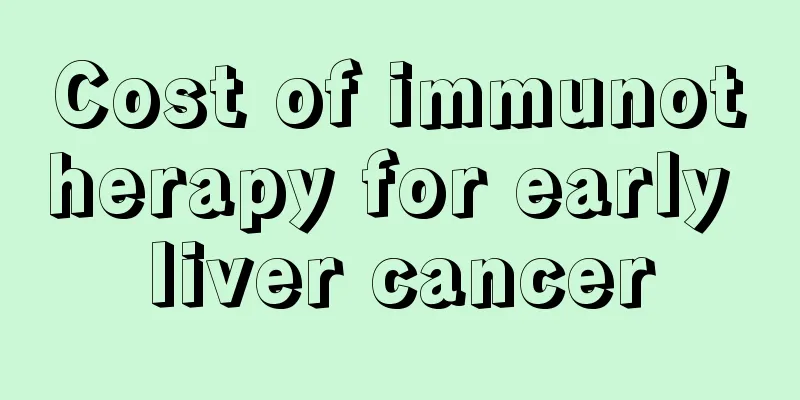Prostate cancer treatment options

|
In the general impression of people, cancer means death. In fact, many people have a high 5-year survival rate after treatment. The incidence of prostate cancer is very high in Europe and the United States, but my country is a low-incidence area. Next, let's learn about the treatment options for prostate cancer. The treatment plan for prostate cancer is determined based on the pathological results of prostate biopsy, the patient's age, life expectancy, and the presence or absence of other serious diseases. Treatment options for early prostate cancer can be divided into watchful waiting, hormone therapy, radical prostatectomy, radiotherapy, cryotherapy, and any combination of these. Advanced prostate cancer is often treated with hormone therapy, radiotherapy, chemotherapy, etc. to improve survival rate and quality of life. 1. Watchful waiting Watchful waiting means that after prostate cancer is diagnosed, no treatment intervention is used, but the patient is closely followed up and observed. Once the patient shows signs of disease progression such as elevated PSA, other means of treatment will be used. Generally, patients who use this method should be older than 70 years old, have low tumor stage, well-differentiated tumor, and have a life expectancy of less than 10 years. 2. Radical prostatectomy Radical prostatectomy refers to the surgical treatment of removing the entire prostate and bilateral seminal vesicles. Radical prostatectomy is the first choice for radical treatment of early prostate cancer. Generally, patients who are estimated to be curable before surgery, with an expected life expectancy of more than 10 years and good tumor staging and grading are selected for radical prostatectomy. Complications of radical prostatectomy include urinary incontinence, urethral stenosis, erectile dysfunction, etc. With the development of technology, minimally invasive surgery can now be performed with the help of laparoscopy and robots. 3. Radiotherapy Radiotherapy includes external radiotherapy and internal radiotherapy. External radiotherapy now mainly refers to three-dimensional conformal radiotherapy, which is a painless treatment performed in an outpatient clinic, and the treatment effect is equivalent to radical prostatectomy. Its advantage is that the therapeutic rays are more concentrated on the prostate receiving treatment, reducing the impact on surrounding tissues. External radiotherapy can cause acute cystitis, prostatitis and enteritis. 4. Hormone therapy All treatments that reduce the level of androgen in the blood are called hormone therapy. Because the occurrence and development of prostate cancer is closely related to androgen, treatment that blocks or reduces androgen can significantly reduce tumor size, reduce tumor growth rate and the occurrence of metastasis, but it cannot cure prostate cancer. 5. Isotope therapy is mainly aimed at the treatment of bone metastasis, which is a common complication of prostate cancer. The use of radioactive isotopes can kill cancer cells in the bone metastasis site and also has a certain effect on bone pain. 6. Chemotherapy Some prostate cancer patients have mutated tumor cells that are no longer sensitive to hormone therapy, or for patients with advanced prostate cancer, chemotherapy can be considered. Commonly used drugs include estradiol nitrogen mustard, paclitaxel, docetaxel, mitoxantrone, prednisone and other combinations of different drugs. Common side effects of chemotherapy include nausea, vomiting, anorexia, leukemia reduction, hair loss, etc. Through the above understanding, we know that there are many treatment methods for prostate cancer, each of which has its advantages and disadvantages. In clinical practice, doctors will choose the appropriate method according to the specific situation of the patient and formulate a treatment plan with a single method or a combination of multiple methods. |
<<: Treatment of limited-stage high-risk prostate cancer
>>: Current treatment situation faced by prostate cancer patients and their families
Recommend
Can a tooth be extracted if you have pulpitis?
Tooth extraction is possible for pulpitis, but it...
Are there risks with prostate cancer surgery? Any surgery has risks
Cancer may occur in any organ or tissue of the hu...
How to do hyaluronic acid hydrotherapy
With the improvement of living standards, people ...
Causes of coccyx protrusion
Humans have gradually evolved from the most primi...
Analysis of various treatment methods for gastric cancer
Generally speaking, the incidence of gastric canc...
Does hiccups and ear pain mean otitis media?
I believe everyone knows that otitis media is a r...
Have you followed the precautions for acute nephrotic syndrome?
Acute nephrotic syndrome is a disease with a rela...
Why does it hurt inside after sex? Why does it hurt inside after sex?
Pain after intercourse may be a phenomenon of inf...
How to keep a good mood
Having a good mood is very helpful to the body, e...
How to fall asleep quickly at noon
One third of a person's life is spent sleepin...
When is the best time to treat umbilical cord injury? What are the treatments?
Umbilical cord hair is a type of excess tissue an...
How to wash away blood stains that have been there for a long time
In our daily life, I believe that many female fri...
Is it better to have soft or hard bones?
Generally speaking, when we are younger, our bone...
What foods are good for esophageal cancer patients? Dietary principles for esophageal cancer patients
Esophageal cancer is also known as esophageal can...
What to do if your skin turns dark after sun exposure
It's a hot summer, and women who love beauty ...









